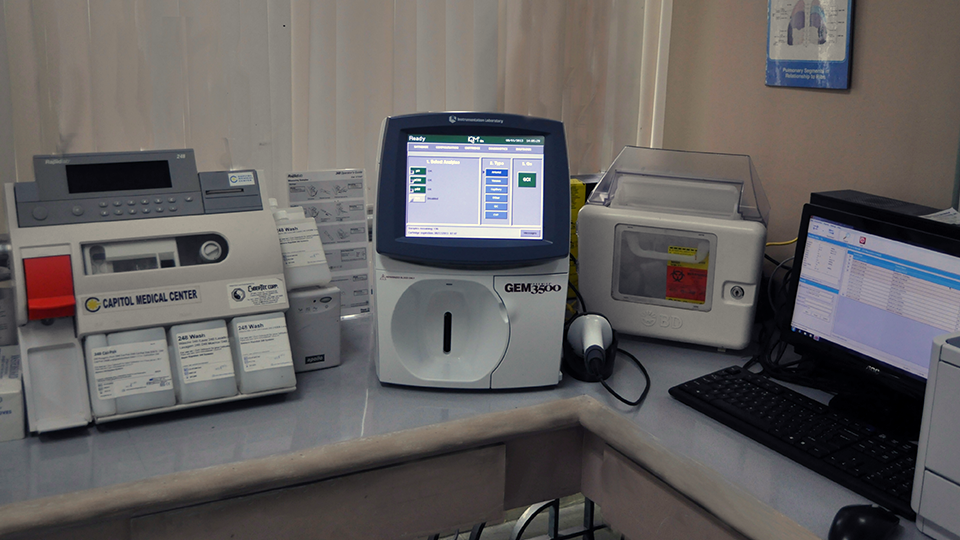Medical Services List:
- Acute Stroke Unit
- Ambulatory Oncology Treatment
- Breast Care Center
- Cardiac Catheterization Lab
- Child Development Unit
- Clinical Neurophysiology Lab
- CT or CAT Scan
- Diabetic Foot & Wound Center
- Dialysis Center
- Ear, Nose & Throat Center
- Emergency Unit 24/7
- Endoscopy Unit
- Eye Center
- Labor or Birthing Room
- Magnetic Resonance Imaging
- Minimally Invasive Surgery
- Non-Invasive Cardio Lab
- Nuclear Medicine
- OB Sonology / OB Ultrasound
- Plastic & Cosmetic Surgery
- Pulmonary Laboratory
- Sleep Center
- Skin Center
- Stone Center
- Vitality Center
Clinic Schedule:

Pulmonary Laboratory
Our Pulmonary Laboratory is equipped with modern facilities to serve the need for diagnosis or therapy of patients with acute and chronic pulmonary conditions. Our wide range of lung function testing and exercise tests assist physicians in diagnosing and managing patients with breathing problems or lung disease. From ultrasonic nebulizers to volume respirators, we attend to immediate needs and administer the right pulmonary function tests to spot disease as early and accurately as possible.
Advocating for healthy lungs and a healthy life, our Pulmonary Lab gets to the bottom of breathing-related symptoms and helps confirm the presence of disease. Our testing also assesses how our patients are responding to a variety of treatments.
The section of the center for respiratory medicine is equipped with modern facilities to serve both diagnostic and therapeutic needs of patients with acute and chronic pulmonary disorders.
Services Offered:
- Pulmonary function test (Pre/Post Bronchodilator) – bring together measurements of flow and volumes with gas analysis to determine how well the lungs work. These measurements of lung volume, capacities, flow rates and gas exchange.
- Maximal inspiratory pressure / Maximal expiratory pressure (MIP/MEP) – A test of total respiratory muscle strength, recording the pressure you generate while attempting to inhale or exhale. The pressure is correlated with the overall strength of the breathing muscles and may help assess possible respiratory muscle weakness.
- Airway resistance – For this test, you sit in a “booth” and breathe through a mouthpiece while pressure and airflow measurements are collected.
- Lung diffusion capacity (DIco) – Measures how well oxygen passes from your lungs to your bloodstream. During the test, the patient breathes in a type of gas through a tube, holds their breath briefly, and then blows out the gas.
- Lung volumes – Provide useful insight confirming the presence of restrictive lung disease, as suggested by a low vital capacity on a spirometry test.
- Arterial blood gasses (ABG) – Measures the acidity and levels of oxygen and carbon dioxide in the blood from an artery. This test checks how well your lungs are able to move oxygen into the blood and remove carbon dioxide from it.
- Chest Physiotherapy – to loosen and aid in the removal of lung secretions and to promote re-expansion of lung tissue.
- Incentive spirometry – Several types of exercise testing composed of baseline spirometry, a period of vigorous exercise, and repeat spirometry at defined intervals.
- Peak Flow meter – to determine and detect if there are changes in airways that signal a worsening of symptoms or improvement in breathing function for people with respiratory conditions such as asthma and emphysema.
- CPAP/BIPAP machine – a device that helps with breathing. During normal breathing, your lungs expand when you breathe in.
- Nasal high flow machine
- Mechanical ventilator machine – is a form of life support. A mechanical ventilator is a machine that takes over the work of breathing when a person is not able to breathe enough on their own. The mechanical ventilator is also called a ventilator, respirator, or breathing machine.
- Intermittent positive pressure breathing – to provide short term or intermittent mechanical ventilator assistance for the purpose of volume augmentation in selected patients who need less invasive therapies.
- Sputum Induction - procedure to help a patient cough up secretions from the lungs more easily.
Team of Doctors
Pulmonologist:
- Dr. Balanag, Vicente Jr
- Dr. Cambonga, Mander
- Dr. Chavez, Joselito
- Dr. Dalupang, Julius Caesar
- Dr. De Jesus, Arlene
- Dr. De Leon, Gabriel
Team of Doctors
Pulmonologist:
- Dr. Diaz, Rei Paolo
- Dr. Fajardo, Ronald
- Dr. Gonong, Joven Roque
- Dr. Navarrete, Edgardo
- Dr. Ong-Cabrera, Glynna
- Dr. Zamora, Prescillano Jr.
(02) 8372-3825 local 4251
FAQ 1:
Lorem ipsum dolor sit amet, consectetur adipiscing elit. Ut elit tellus, luctus nec ullamcorper mattis, pulvinar dapibus leo.
FAQ 2:
Lorem ipsum dolor sit amet, consectetur adipiscing elit. Ut elit tellus, luctus nec ullamcorper mattis, pulvinar dapibus leo.
FAQ 3:
Lorem ipsum dolor sit amet, consectetur adipiscing elit. Ut elit tellus, luctus nec ullamcorper mattis, pulvinar dapibus leo.



